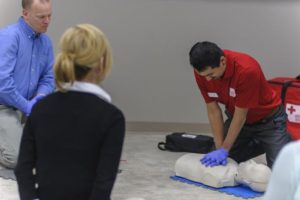CPR rescuers learn how to correctly give CPR through a training course in basic or advanced CPR. We at San Francisco CPR have the best training programs in the city. Compared to other training providers, we have very affordable rates and high quality training. Eight programs are scheduled through the week; we open classes during the evenings and weekends if our regular schedules cannot accommodate all the trainees who sign up. Rest assured, at San Francisco CPR you will receive the best CPR training.
Basic First Aid lessons
Included in all our CPR training programs are basic first aid classes, focused on common injuries – from minor burns to severe bleeding. We want our trainees to be well-rounded in terms of lifesaving skills so we include both CPR and first aid in our training programs. Also, a situation where CPR is needed will also most likely need first aid management as well, especially if the victim falls and injures themselves.
First aid lessons include popular topics such as: bandaging, wound care, burn care, bleeding management, splinting, and many other skills.
Learning CPR and AED
Our CPR training programs are available in two categories: basic and advanced CPR. Out of our eight programs, we have one (a basic course) available to the public. The rest of our basic courses are for health care providers while both advanced courses are only for health care professionals. Program length ranges from 4 hours to 16 hours. Advanced courses are longer and take two days to finish.
Program list
- Heartsaver CPR (basic) – 4 hrs., general public
- Heartsaver C (basic) – 4.5 hrs.
- Basic Life Support for health care providers (basic) – 4.5 hrs.
- Basic Life Support for HCPs re-certification – 4 hrs.
- Advanced Cardiac Life Support (advanced) – 16 hrs.
- ACLS re-certification – 5 hrs.
- Pediatric Advanced Life Support (advanced) – 14 hrs.
- PALS re-certification – 6/8 hrs.
Re-certification classes are only available for three of our programs. Students who have certificates that are approaching expiry and need to be renewed can sign up for a shorter version of the training course – a re-certification class. However, in the case that your certificate has passed its expiration date, you can no longer apply for re-certification; you have to take the training course again. Remember to renew before your 24 months is up!
CPR and AED
Cardiovascular resuscitation (CPR) is used to help restore the spontaneous circulation of blood in the body by forcing the heart to beat manually. Chest compressions need to be given at a rate of at least 100 per minute, with a ratio of 30 compressions to 2 ventilations. Trained rescuers are able to perform both compressions and ventilations while untrained rescuers are advised to stick with hands-only CPR rescue (chest compressions only).
AEDs are another thing entirely. They are not used during asystole or flat line. They are used when the victim is experiencing very severe arrythmia, such as ventricular fibrillation. The electricity from the AED is meant to shock the heart back into a normal rhythm. However, AEDs are only typically found with EMTs.

